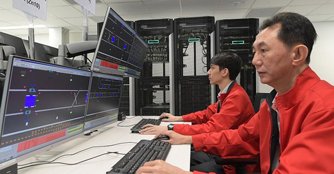East-West Line running on new signalling system now
28 May 2018|2,676 views
The East-West Line (EWL) has switched over to a new signalling system, and, going by the first morning on Monday (28th May), all seems well despite the rain. The EWL is the second old line to switch over to the new Communications-Based Train Control (CBTC) signalling system, after the North-South Line (NSL) last year. Compared with the NSL, the switch was smoother and less disruptive on the EWL.
With the new system, continuous service to and from the Tuas West Extension has resumed. That is, trains now do not have to stop at Joo Koon station for commuters to alight, take a shuttle bus to Gul Circle, before hopping on another train to continue their westward journey.
This was the arrangement put in place last November after a train collision that was caused by, among other things, a mismatch between the old signalling system and the new one, which was already in place for the Tuas West Extension.
Commuter Ethan Guo said his journey on the EWL was "smooth and uneventful". The 30-something who works for a non-governmental organisation said, "I sincerely hope this will be the start of the higher train frequency that we were promised with the CBTC."
In a Facebook post on Sunday, Transport Minister Khaw Boon Wan said, "After five uneventful Sunday testing (sessions) of the new signalling system for EWL, we are now ready to put the system to its final test - all-day testing of the entire line during the June school holidays.
"The last time we did the same for the NSL last year, we encountered many teething problems. With extended engineering hours, we expect a... smoother implementation for EWL this time. "But still, one can never be sure until it is put to the test. We will be closely monitoring (the situation)."
The East-West Line (EWL) has switched over to a new signalling system, and, going by the first morning on Monday (28th May), all seems well despite the rain. The EWL is the second old line to switch over to the new Communications-Based Train Control (CBTC) signalling system, after the North-South Line (NSL) last year. Compared with the NSL, the switch was smoother and less disruptive on the EWL.
With the new system, continuous service to and from the Tuas West Extension has resumed. That is, trains now do not have to stop at Joo Koon station for commuters to alight, take a shuttle bus to Gul Circle, before hopping on another train to continue their westward journey.
This was the arrangement put in place last November after a train collision that was caused by, among other things, a mismatch between the old signalling system and the new one, which was already in place for the Tuas West Extension.
Commuter Ethan Guo said his journey on the EWL was "smooth and uneventful". The 30-something who works for a non-governmental organisation said, "I sincerely hope this will be the start of the higher train frequency that we were promised with the CBTC."
In a Facebook post on Sunday, Transport Minister Khaw Boon Wan said, "After five uneventful Sunday testing (sessions) of the new signalling system for EWL, we are now ready to put the system to its final test - all-day testing of the entire line during the June school holidays.
"The last time we did the same for the NSL last year, we encountered many teething problems. With extended engineering hours, we expect a... smoother implementation for EWL this time. "But still, one can never be sure until it is put to the test. We will be closely monitoring (the situation)."
Latest COE Prices
August 2025 | 1st BIDDING
NEXT TENDER: 20 Aug 2025
CAT A$102,009
CAT B$123,498
CAT C$70,001
CAT E$122,334
View Full Results Thank You For Your Subscription.



















